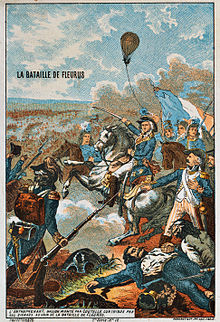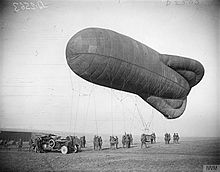Observation balloon

An observation balloon is a type of balloon that is employed as an aerial platform for intelligence gathering and artillery spotting. Use of observation balloons began during the French Revolutionary Wars, reaching their zenith during World War I, and they continue in limited use today. Synonyms include espionage balloon, reconnaissance balloon, or surveillance balloon.
Historically, observation balloons were filled with hydrogen. The balloons were fabric envelopes filled with hydrogen gas, whose flammable nature led to the destruction of hundreds of balloons on both sides. Observers manning these observation balloons frequently had to use a parachute to evacuate their balloon when it came under attack. To avoid the potentially flammable consequences of hydrogen, observation balloons after World War I were often filled with non-flammable helium.
Typically, balloons were tethered to a steel cable attached to a winch that reeled the gasbag to its desired height (usually 1,000-1,500 metres) and retrieved it at the end of an observation session.
History[]

The first military use of observation balloons was by the French Aerostatic Corps during the French Revolutionary Wars, the very first time during the Battle of Fleurus (1794).[1] The oldest preserved observation balloon, L'Intrépide, is on display in a Vienna museum. They were also used by both sides during the American Civil War (1861–65)[2] and continued in use during the Franco-Prussian War (1870–71).[3] Balloons were first deployed by the British Army's Royal Engineers during the expeditions to Bechuanaland in 1884 and Suakin in 1885.[4] They were also deployed during the Second Boer War (1899–1902), where they were used in artillery observation at the Battle of Magersfontein and during the Siege of Ladysmith.[5]


World War I was the high point for the military use of observation balloons, which were extensively deployed by both sides. Artillery had developed to the point where it was capable of engaging targets beyond the visual range of a ground-based observer. Positioning artillery observers on balloons, generally a few miles behind the front lines and at altitude, allowed them to see targets at greater range than they could on the ground. This allowed the artillery to take advantage of its increased range.[6]
The British, despite their experience in late 1800s Africa, were behind developments and were still using spherical balloons. These were quickly replaced by more advanced types, known as kite balloons, which were aerodynamically shaped to be stable and could operate in more extreme weather conditions. The Germans first developed the Parseval-Siegsfeld type balloon, and the French soon responded with the Caquot type.[7]
Because of their importance as observation platforms, balloons were defended by anti-aircraft guns, groups of machine guns for low altitude defence and patrolling fighter aircraft. Attacking a balloon was a risky venture but some pilots relished the challenge. The most successful were known as balloon busters, including such notables as Belgium's Willy Coppens, Germany's Friedrich Ritter von Röth, America's Frank Luke, and the Frenchmen Léon Bourjade, Michel Coiffard and Maurice Boyau. Many expert balloon busters were careful not to go below 1,000 feet (300 m) in order to avoid exposure to anti-aircraft guns and machine-guns.
World War I observation crews were the first to use parachutes, long before they were adopted by fixed wing aircrews. These were a primitive type, where the main part was in a bag suspended from the balloon, with the pilot only wearing a simple body harness around his waist, with lines from the harness attached to the main parachute in the bag. When the balloonist jumped, the main part of the parachute was pulled from the bag, with the shroud lines first, followed by the main canopy. This type of parachute was first adopted by the Germans and then later by the British and French for their observation balloon crews.[6]
Kite balloons began to be used at sea for anti-submarine purposes towards the end of World War I.[8] The Red Army of the Soviet Union used Observation Balloons for artillery spotting. 8 "Aeronautical Sections" existed and 19,985 observation flights were performed by balloonists of the Red Army during the Second World War, clocking up 20,126 flight hours. 110 Soviet Observation Balloons were lost. Observation balloons also played a role during the Cold War; for example, Project Mogul used high-altitude observation balloons to monitor Soviet nuclear tests. However, heavier-than-air craft now performed the vast majority of operations. Aerostats have been used by US and coalition military forces in Iraq and in Afghanistan.[9]
The idiom "The balloon's going up!" as an expression for impending battle is derived from the very fact that an observation balloon's ascent likely signaled a preparatory bombardment for an offensive.[10]
The advent of spy satellites, coupled with the end of the Cold War, have rendered espionage balloons mostly obsolete.
Notable programs[]
See also[]
- Balloon (aircraft)
- Barrage balloon
- Tethered balloon
- List of American Balloon Squadrons
- Surveillance aircraft
- Surveillance blimp
References[]
- ^ Thompson, Holland (1920). The World's greatest war from the outbreak of the war to the Treaty of Versailles. Grolier. p. 243.
- ^ "Balloons in the American Civil War". CivilWar.com. Archived from the original on 9 January 2015.
- ^ "A History of Aeronautics". The World Wide School. November 1997. Archived from the original on 28 January 2004.
- ^ "Early military ballooning". Royal Air Force Museum. Archived from the original on 19 May 2013. Retrieved 22 September 2014.
- ^ "The Boer War". Royal Air Force Museum. Archived from the original on 27 March 2017. Retrieved 22 September 2014.
- ^ a b "Observation Balloons on the Western Front". The Western Front Association. 29 June 2008.
- ^ Ege, L.; Balloons and Airships, Blandford, 1973. p. 68.
- ^ "Kite Balloons in Escorts". Naval History and Heritage Command.
- ^ "High-Tech Balloon to Help Forces Keep Watch". The Washington Post. 20 August 2009.
- ^ "What Is the Origin of the Saying "Once the Balloon Has Gone Up"?". Grammar Monster.
- ^ Peebles, Curtis, 1991. The Moby Dick Project: Reconnaissance Balloons over Russia. Smithsonian Books, ISBN 1-56098-025-7
- ^ Fowler, Shane (25 July 2017). "Mystery solved: 'Thing in the woods' revealed as CIA spy camera, 55 years later". Canadian Broadcasting Corporation. Retrieved 26 July 2017.
External links[]
| Wikimedia Commons has media related to Observation balloons. |
- Memoirs & Diaries - In a Kite Balloon at First World War.com
- The Parseval-Siegsfeld Kite Balloon in Flight
- Nighttime photography, a description of WW2 aerial reconnaissance photography by Harold Eugene Edgerton
- Balloons (aeronautics)
- Reconnaissance aircraft
- Earth observation platforms